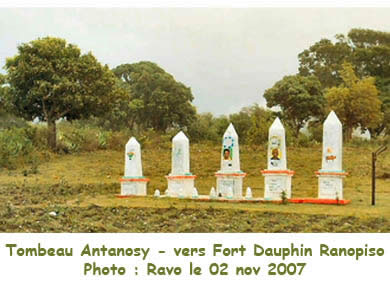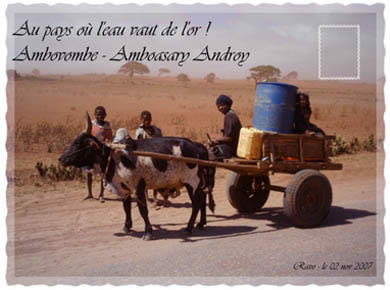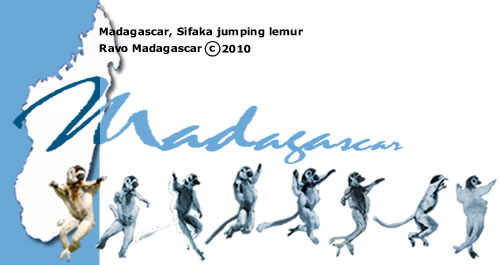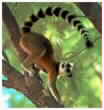|
The Deep South part of Madagascar
is the extreme South part of Madagascar ; the country of Vezo, Mahafaly and Antandroy ( the 3 tribes of this region ). You have 2 ways to go there, the both are very bad roads & are only available in the dry season from June to November. The first way is along the sea-side path passing by : Beheloka - Efoetse - Itampolo - Saodona - Bevoalavo - Lavanono - Cap Sainte Marie - Faux Cap. The 2nd way is the national road which is as bad as the sea-side path ( the both need a 4 WD vehicle ), passing by : Betioky - Ejeda - Ampanihy - Beloha - Tsiombe - Ambovombe Androy. Your car runs through rivers in dry season because there is no water.

The Deep South part of Madagascar
Is the land of spiny bushes, goats & zebus ; a lot of zebus ; but also the land of drought. The only region of Madagascar where people don't grow rice ( because of the lack of rain & limestone ground or sandy ground ). But it's the first region of Madagascar which produces manioc, sweet potatoes, corn, peanuts and beans.
In the Deep South part of Madagascar
You will be in contact with Vezo, Antandroy and Mahafale people. The Vezo people are fishermen. The Antandroy people are pastors ( they breed zebus & oxes ). And the Mahafale people grow crops. The vegetation includes Euphorbiaceae, Liliaceae ( such as aloes ), Apocynaceae ( such as bottle-trees ) and Didieraceae ( all endemic ). Most of plants in this region are endemic & it's the part of Madagascar where the rain is the lowest : from 600 mm/year to ... 300 mm/year. To compare it, the part of Madagascar with the highest rain is the North East region, with 3500 mm/year. Everyday, it rains there. But here, it's the land of zebus & spiny plants.
|
Zebu civilization in the South of Madagascar :
The zebus are the most important things for the Antandroy people. They are not sacred but the Antandroy people don't hesitate to live their villages to go to grassy ground even if they have comfortable huts, crops fields and water. The Antandroy people know their zebus very well. And the cattle give them happiness , the cattle are the most important wealth for them. They can give them a beautiful burial. So, to steal cattle of other people is a sign of bravery but not a sin for them. And more you have zebus, more the society respects you & gives you honor even if you steal cattle of others.
The spiny land in the South of Madagascar :
The roy [ ruï ] is a spiny plant in the South ; So, Androy [ Andzuï ] means in the country of spiny plants & Antandroy [ Antandzuï ] means the people who live there. For example, there are a lot of cactus there. The people use them to fence their territories. During the pacification in the colonization, the french soldiers were terrified by these plants ( from 1899 to 1904 ). The Compte de Modave has introduced the cactus in the South part of Madagascar in 1770. And these plants have covered all the region. It's a 5m high plant, with yellow flowers & green or purple fruits ( you can eat them ). The people have eaten a lot of cactus fruits during the big drought ( Kere ) in 1991, because after eating them, you are able to not drink for few days. So the lack of water is not a problem for you even if the weather is very hot. The cactus leaves are used to feed zebus and other animals ( goats, sheeps, tortoises )
|

Andohahela National Park
Naturalists & public will like this Park because of its particular forest ecosystem. Andohahela National Park is divided in 3 areas : first, the East area with its evergreen humid forest because of much rains. Second, the West semi-arid part with just 600 to 800 mm of rain per year, so a vegetation of spiny bushes. And third, an intermediary zone between these two different climates. Anosy mountainous chain divides Andohahela National Park in 2 areas : the East region & the West ones. This chain stops the wind from the Indian Ocean, so it stops most of rain, it's the reason why the West part is semi-arid. You can visit Andohahela on foot or by mountain-bike ( you can rent it in Fort Dauphin ), and during the day or the night to try to find lemurs such as Sifaka, Ringtailed lemur or Mouse lemur.
Andohahela National Park ( 76 020 ha ) lies near Fort Dauphin ( a small town in the deep South part of Madagascar ), between 90 & 1972 m of altitude. People in the whole region get water from this Park, and use it to water their fields & ricefields. About Andohahela flora, you can find an uncommon & unique palm tree, a palm tree that you found nowhere else on earth, the Dypsis decaryi. You can find too other amazing medicinal plants such as the Vanilla madagascariensis ( Vahinamalo : not perfumed but men use it like local viagra ), the Cedrelopsis greveii ( Katrafay : when you have diarrhoea ), the Uncarina grandidieri ( Farehitra : when you lost hair & you don't like this), the Cyphostemma laza ( Laza : mediums use it for its magic power ), the Diospyros sp. ( Maintifo : sculptors & carpenters like this tree very much )
|

To discover Madagascar :
Madagascar, island of emotions, is a place like no other. Because of its insularity, it kept its traditions, its habits and customs, its fauna and flora with a high endemic character.
Madagascar has become very attractive for the amateur in search of new discoveries and emotions through hiking and trekking.
Being a professional Malagasy guide since 1993, I have organized and realized a heck of a lot of trips through Madagascar ; also I can make the following proposal to you.
There’s probably no better way to discover the real soul of this magnificent island than to penetrate deep inland in order to feel, touch, smell nature, to be fully submerged in Madagascar’s exuberant natural world. Of course there’ll be times 4WD vehicles and bivouacking will be necessary.
A trip to Madagascar provides an authentic nature experience for anyone seeking to experience it in a thoughtful and responsible way. Shall we see each other soon ?
Thank you for your TRUST.
D1 : Paris – Antananarivo ( Tana )
Welcoming reception at the airport and foreign exchange operation. Transfer to hotel.
D2 : Tana
A city tour of the Malagasy capital : the Artisan’s Marketplace ( possibility to shop ), the Zoological and Botanical Park ( discover here a synopsis of the local fauna and flora, a summary of the indigenous traditions and customs, a foretaste of what will lay ahead ), visit of the Upper and Lower Town of the capital as well as some interesting monuments. Your purchases can be safely stored at the hotel until departure (D17).
D3 : Tana – Morondava
Transfer to airport, flight to Morondava. Afternoon tour of the town and its markets, enjoy the spectacular sunset at the world famous Alley of the Baobabs.
D4 to D10 ( 7 days ) :
Morondava – Bekopaka – Morondava
You’ll be discovering amongst the finest landscape sceneries of Madagascar and experience some true 4x4 road conditions. You’ll be discovering the Baobabs region, the famous Tsingy of Bemaraha, a UNESCO World Heritage site, and a RAMSAR site ( area internationally recognised for its bio-and ecological interest ) ; for nature lovers and birdwatchers, this is it ! You’ll cross some typical Sakalava villages and meet its residents.
The journey includes hiking and trekking, pirogue trips on rivers and lakes, crossing mangroves and crocodile regions ( no fear of any danger, we’re not traversing a movie set ), walking through lemur inhabited forests, and of course a trek through the Tsingy.
For 3 nights we’ll be bivouacking in tents ( your OWN tent, see below for things to bring along with you ) ; the other 4 nights we stay at a hotel.
D11 : Morondava – Antsirabe
A long trip to reach the interior highlands. Discover the region known as the Malagasy Midwest, a kind of ‘No Man’s Land’; stops for pictures of Sakalava villages, volcanic massifs, etc.
|
|
D12 : Antsirabe – Tana
Visit workshops and stores of miniatures ( rickshaws, bicycles, trucks, … ), of embroideries, of precious and semi-precious stones. Discover the Central Highlands, the distinctive red lateritic houses, the numerous ricefields.
D13 : Tana – Maroantsetra
Morning transfer to the airport, flight to Maroantsetra. Afternoon free, stroll through this quiet town with its market rich in exotic fruits.
D14 to D16 ( 3 days ) :
Masoala National Park
With small power-driven boats we’ll be discovering a humid and dense primary forest environment, with some huge trees !
Please do not forget adequate rain gear, boots, mosquito repellent, swimming gear, plastic covers to protect your bags, as rains are frequent in this region. Plastic shoes may be handy for crossing shallow streams, and of course most useful : toilet paper.
Hiking and trekking through rivers and streams, waterfalls, forests with lemurs, birds, frogs, lizards. From time to time we’ll follow quasi-deserted beaches, your opportunity for a refreshing swim.
We’ll spent 3 nights bivouacking in tents ( yours! ) ; the river with its crystal clear water will be your washbasin, and nature will provide the ‘bathroom’.
With the journey in the West, we’ll spend a total of 6 nights bivouacking in tents.
D17 : Nosy Mangabe – Maroantsetra – Tana
Return to Maroantsetra by boat, transfer to the airport, and flight to Tana. Transfer to hotel; recover your purchases, farewell dinner. Transfer to the airport for flight back to Paris.
Cost estimation PER PERSON :
for a couple : 2535 euros
for 4 persons : 1870 euros
for 8 persons : 1700 euros
Price is all inclusive, except for :
Your international flight, visa, personal insurance, personal purchases and expenses, tips, luggage porter at airports and hotels, drinks
You’ll settle all bills locally as we progress through the journey, i.e. in Euros and local currencies.
TO BRING ALONG WITH YOU :
Your own tent, pegs, mattress, sleeping bags ; anti-mosquito spray and cream, pocket torch and spare batteries, head torch if possible, swimsuits, light clothes, but also some warm clothes for the highlands, cameras, small padlocks for your luggage ; your personal medicines such as general antibiotics, anti-diarrhoea, antiseptics, e,g, Betadine, compresses and cotton, ointment for sprains, lip cream or gel ; protect yourself against malaria, e.g. follow a treatment. Sun cream ; walking shoes or closed sports shoes, binoculars if necessary, old clothes ( children’s and adults’ ) to give here and there during the trip ( also biros, colour pencils, old dolls, teddy-bears, small balloons, etc. ) ; Swiss knife, k-way or windcheater, hat or cap, etc. AND cash money = Euros.
|
The South part of Madagascar
is the most exotic part of this big island. Its forests are home to thorny, water-retaining trees and shrubs which are unique to Madagascar. Due to its hot, sunny climate, the south is a popular tourist destination, especially in Fort Dauphin and Toliary regions. The wooden carvings and colourful paintings which decorate the ancestral tombs of Antandroy, Mahafaly and Antanosy tribes add unique character to the area and provide a haven for cultural enthusiasts and nature lovers.
Isalo National Park is one of Madagascar's most popular hiking destinations. The deeply eroded, weirdly shaped sandstone rocks and the rare endemic plants make it particularly rewarding for botanist. The absolute silence which exists creates an awe-inspiring sense of isolation and timelessness. The area is very hot and rugged so the water-filled canyons which act as natural swimming pools are a welcome relief to traveller.
On the southernmost point of Madagascar are Faux Cap and Cap Sainte Marie. Faux Cap is a beautiful isolated spot with huge shifting sand dunes and wild breakers. Cap Sainte Marie is a spectacular reserve with high sandstone cliffs and dwarf plants. Always in this South part of Madagascar, let's talk about another National Park :
Andringitra National Park, Madagascar
Has an area of 31 160 ha with an elevation range between 650 and 2658 m. Andringitra became a National Park only in 1999. So it's one of the newest National Parks in Madagascar. The Park is within Fianarantsoa Province, in the Betsileo area. It's very cold there in winter ( in July ) where you can have 7° C below 0. And the rainiest month is February.
Andringitra National Park
Can be divided in two sides, the western side and the eastern one. This eastern domain is a lowland humid forest, and the western domain contains montane forest and dwarf montane flora. Most of them are endemic. Approximately 1000 species of plants have been inventoried within the Park. You can find a lot of fern flora. There is too there around 106 species of birds, 13 species of primates, 57 species of amphibians and 35 species of reptiles ; most of them are endemic to Madagascar.
For more information, you can write to the following people.
They have alot of experiences about travel and big travel. I have had the opportunity to meet them, I was their tour guide during their trip in Madagascar. Thanks alot to them to permit me to put their names and adresses on this web site. Don't hesitate to contact them and thank you so much :
|
|
This last person ( Erik Segers ) has written in « LinkedIn » :
If you want to discover Madagascar, Ravo is your man to organise your trip from A to Z. Thanks to his deep knowledge and boundless enthusiasm we had a truly first class visit of this wonderful island. Without a doubt, I do recommend, wholeheartedly.

|
Clients' Testimony after their trip in Madagascar :
Whenever I think of Mada ( Madagascar ), I still hear the kids laughter … It’s the first thing that comes to my mind … Ravo, your laughter as well, although I have to admit, it has faded a bit. A journey to Madagascar isn’t an ordinary trip. I liked what you said one day : we behaved as travellers not as tourists. Once the decision is made to go on holiday to Madagascar, it’s more than just a holiday … It is an encounter with people. It is a discovery of stunning landscapes, of great variety. Mada is a mix of colours, a land of contrasts between ochre and green. It is the cold of the high plateaux, the heat of the South.
As soon as we arrived, at the airport, you welcomed us so amiably that we felt immediately confident with you. The trip being short, you managed to get us into the island mood from day one. We are fully aware you’ve done everything possible to satisfy “ your clients ” while crossing this island. We never felt we were clients though !!! Thanks to you Ravo … Your professionalism, your knowledge of the island, and above all your love for the inhabitants of Mada are the key to the success of our journey.
Every day had its emotions : the discovery of a village, of a landscape, of a new region. Emotions when we shared the joy of children running up to our bus. I still see them coming from far away … Emotions when you negotiated with the village chief to visit his hamlet, better even to enter some houses. Do you still remember Ravo, I forgot the name of the village, that place where a young blond girl of our party got surrounded by only black kids … it was quite emotional. I still can remember the smell of burning charcoal, that odour a little bit acrid whenever we crossed the villages. And those market places ! Those stands of fruit !!! I still see also those people of the highlands protecting themselves from the cold with the same blanket they use for bedding. So many memories ... Elisabeth and Georges CLERC
To see our Madagascar Pictures' Gallery
(more than 88 pictures), click on :

RATSIMBAZAFY Ravo Nomenjanahary & Pierrette
Copyright © 2000 Christian-thought
e-mail : r_ravo@hotmail.com
Phone 261 20 32 41 063 65

The Christian Counter


Webspace Provider
|
|
|
|
|